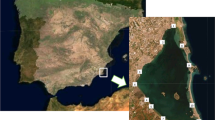Abstract
Heavy metal (As, Cd, Cu, Pb, Zn, Hg and Se) concentrations in the muscle and bone of four fish species (Mullus barbatus, Merluccius merluccius, Micromesistius poutassou, and Scomber scombrus) from the central Adriatic Sea were measured and the relationships between fish size (length and weight) and metal concentrations in the tissues were investigated. Samples were analyzed by inductively coupled plasma-atomic emission spectrophotometry with automatic dual viewing. In the muscle, results of linear regression analysis showed that, except for mercury, significant relationships between metal concentrations and fish size were negative. Only mercury levels were positively correlated with Atlantic mackerel size (p < 0.05). No significant variations of heavy metal concentrations were observed in muscles of the examined species, but a significant difference (p < 0.01) was found for As, Cd, Pb, and Se concentrations in bone. All the investigated metals showed higher values in the muscle than in bone, except for lead and zinc. Regarding cadmium, lead, and mercury maximum levels, set for the edible portion by European legislation, several samples exceeded these values, confirming the heavy metal presence in species caught near the Jabuka Pit.



Similar content being viewed by others
References
Al-Yousuf, M. H., El-Shahawi, M. S., & Al-Ghais, S. M. (2000). Trace metals in liver, skin and muscle of Lethrinus lentjan fish species in relation to body length and sex. Science of the Total Environment, 256, 87–94.
Artegiani, A., Azzolini, R., & Salusti, E. (1989). On the dense water in the Adriatic Sea. Oceanologica Acta, 12, 151–160.
Barak, N. A., & Mason, C. F. (1990). Mercury, cadmium and lead in eels and roach: the effects of size, season and locality on metal concentrations in flesh and liver. Science of the Total Environment, 92, 249–256.
Bervoets, L., & Blust, R. (2003). Metal concentrations in water, sediment and gudgeon (Gobio gobio) from a pollution gradient: relationship with fish condition factor. Environmental Pollution, 126, 9–19.
Beyrouty, P., & Chan, H. M. (2006). Co-consumption of selenium and vitamin E altered the reproductive and developmental toxicity of methylmercury in rats. Neurotoxicology and Teratology, 28, 49–58.
Bilandžić, N., Dokić, M., & Sedak, M. (2011). Metal content determination in four fish species from the Adriatic Sea. Food Chemistry, 124, 1005–1010.
Bilandžić, N., Ðokić, M., Sedak, M., Varenina, I., Kolanovic, B. S., Drazen, O., et al. (2012). Determination of copper in food of animal origin and fish in Croatia. Food Control, 27, 284–288.
Burger, J., & Gochfeld, M. (2011). Mercury and selenium levels in 19 species of saltwater fish from New Jersey as a function of species, size, and season. Science of the Total Environment, 409, 1418–1429.
Cabañero, A. I., Madrid, Y., & Cámara, C. (2007). Mercury–selenium species ratio in representative fish samples and their bioaccessibility by an in vitro digestion method. Biological Trace Element Research, 119, 195–211.
Canli, M., & Atli, G. (2003). The relationships between heavy metal (Cd, Cr, Cu, Fe, Pb, Zn) levels and the size of six Mediterranean fish species. Environmental Pollution, 121, 129–136.
Carvalho, C. M. L., Chew, E. H., Hashemy, L. I., Lu, J., & Holmgren, A. (2008). Inhibition of the human thioredoxin system: a molecular mechanism of mercury toxicity. Journal of Biological Chemistry, 283, 913–923.
Copat, C., Bella, F., Castaing, M., Fallico, R., Sciacca, S., & Ferrante, M. (2012). Heavy metals concentrations in fish from Sicily (Mediterranean Sea) and evaluation of possible health risks to consumers. Bulletin of Environmental Contamination and Toxicology, 88, 78–83.
de Juan, S., & Lleonart, J. (2010). A conceptual framework for the protection of vulnerable habitats impacted by fishing activities in the Mediterranean high seas. Ocean Coastal Management, 53, 717–723.
EC. (2006). Commission Regulation (EC) No. 1881/2006 of 19 December 2006 setting maximum levels for certain contaminants in foodstuffs. Official Journal of the European Union L, 364, 5–24.
EC. (2008). Commission Regulation (EC) No. 629/2008 of 2 July 2008 amending Regulation (EC) No. 1881/2006 setting maximum levels for certain contaminants in foodstuffs. Official Journal of the European Union L, 173, 6–9.
FAO, 2012. Capture production 1950–2010. FAO Fisheries Department, Fishery Information, Data and Statistics Unit, Rome.
Franco, P., Jertié, L., Malanotte-Rizzoli, P., Michelato, A., & Orlié, M. (1982). Descriptive model of the Northern Adriatic. Oceanologica Acta, 3, 379–389.
Ginsberg, G. L., & Toal, B. F. (2009). Quantitative approach for incorporating methylmercury risks and omega-3 fatty acid benefits in developing species-specific fish consumption advice. Environmental Health Perspectives, 117, 267–275.
Goyer, R. A. (1997). Toxic and essential metal interactions. Annual Review of Nutrition, 17, 37–50.
Guérin, T., Chekri, R., Vastel, C., Sirot, V., Volatier, J. L., Leblanc, J. C., et al. (2011). Determination of 20 trace elements in fish and other seafood from the French market. Food Chemistry, 127, 934–942.
Has-Schon, E., Bogut, I., & Strelec, I. (2006). Heavy metal profile in five fish species included in human diet, domiciled in the end flow of River Neretva (Croatia). Archives of Environmental Contamination and Toxicology, 50, 545–551.
Kljaković Gašpić, Z., Znovarić, T., Vrgoč, N., Odžak, N., & Barić, A. (2002). Cadmium and lead in selected tissues of two commercially important fish species from the Adriatic Sea. Water Research, 36, 5023–5028.
McCoy, C. P., Hara, T. M., Bennett, L. W., Boyle, C. R., & Lynn, B. C. (1995). Liver and kidney concentrations of zinc, copper and cadmium in channel catfish (Ictalurus punctatus): variation due to size, season and health status. Veterinary and Human Toxicology, 37, 11–15.
Monterio, L. R., & Lopes, H. D. (1990). Mercury content of swordfish, Xiphias fladius, in relation to length, weight, age and sex. Marine Pollution Bulletin, 21, 293–296.
Nash, R. D. M., Valencia, A. H., & Geffen, A. J. (2006). The origin of Fulton’s condition factor—setting the record straight. Fisheries, 31, 236–238.
Nussey, G., Van Vuren, J. H. J., & du Preez, H. H. (2000). Bioaccumulation of chromium, manganese, nickel and lead in the tissues of the moggel, Labeo umbratus (Cyprinidae), from Witbank dam, Mpumalanga. Water SA, 26, 269–284.
Perugini, M., Visciano, P., Manera, M., Zaccaroni, A., Olivieri, V., & Amorena, M. (2009). Levels of total mercury in marine organisms from Adriatic Sea, Italy. Bulletin of Environmental Contamination and Toxicology, 83, 244–248.
Perugini, M., Visciano, P., Manera, M., Abete, M. C., Gavinelli, S., & Amorena, M. (2013). Contamination of different portions of raw and boiled specimens of Norway lobster by mercury and selenium. Environmental Science and Pollution Research. doi:10.1007/s11356-013-1804-9.
Peterson, S. A., Ralston, N. V. C., Whanger, P. D., Oldfield, J. E., & Mosher, W. D. (2009). Selenium and mercury interactions with emphasis on fish tissue. Environmental Bioindicators, 4, 318–334.
Pinheiro, M. C. N., de Nascimento, J. L. M., Silveira, L. C. L., daRocha, J. B. T., & Aschner, M. (2009). Mercury and selenium—a review on aspects related to the health of human populations in the Amazon. Environmental Bioindicators, 4, 222–245.
Ralston, N. V. C. (2009). Introduction to 2nd issue on special topic: selenium and mercury as interactive environmental indicators. Environmental Bioindicators, 4, 286–290.
Raymond, L. J., & Ralston, N. V. C. (2004). Mercury:selenium interactions and health implications. Seychelles Medical Dental Journal, 17, 72–77.
Saei-Dehkordi, S. S., Fallah, A. A., & Nematollahi, A. (2010). Arsenic and mercury in commercially valuable fish species from the Persian Gulf: influence of season and habitat. Food and Chemical Toxicology, 48, 2945–2950.
Scudder, B. C., Chaser, L. C., Wentz, D. A., Bauch, N. J., Brigham, M. E., Moran, P. W., et al. (2009). Mercury in fish, bed sediment, and water from streams across the United States, 1998–2005. US Dept of Interior, Report 2009-5109, Reston, Virginia, p. 74.
Sonesten, L. (2003). Fish mercury levels in lakes—adjusting for mercury and fish-size covariation. Environmental Pollution, 125, 255–265.
Sormo, E. G., Ciesielski, T. M., Øverjordet, I. B., Lierhagen, S., Eggen, G. S., Berg, T., et al. (2011). Selenium moderates mercury toxicity in free-ranging freshwater fish. Environmental Science and Technology, 45, 6561–6566.
Tankéré, S. P. C., Price, N. B., & Stathama, P. J. (2000). Mass balance of trace metals in the Adriatic Sea. Journal of Marine Systems, 25, 269–286.
Van Der Oost, R., Beyer, J., & Vermeulen, N. P. E. (2003). Fish bioaccumulation and biomarkers in environmental risk assessment: a review. Environmental Toxicology and Pharmacology, 13, 57–149.
WHO/IPCS, 1989. Lead environmental aspects. Environmental Health Criteria 85.
Yi, Y. J., & Zhang, S. H. (2011). The relationships between fish heavy metal concentrations and fish size in the upper and middle reach of Yangtze River. Procedia Environmental Science, 8, 1726–1734.
Acknowledgment
This work has been supported by Ministry of University and Scientific and Technological Research (M.U.R.S.T.) grants (MPI 40 % 2002).
Author information
Authors and Affiliations
Corresponding author
Rights and permissions
About this article
Cite this article
Perugini, M., Visciano, P., Manera, M. et al. Heavy metal (As, Cd, Hg, Pb, Cu, Zn, Se) concentrations in muscle and bone of four commercial fish caught in the central Adriatic Sea, Italy. Environ Monit Assess 186, 2205–2213 (2014). https://doi.org/10.1007/s10661-013-3530-7
Received:
Accepted:
Published:
Issue Date:
DOI: https://doi.org/10.1007/s10661-013-3530-7




